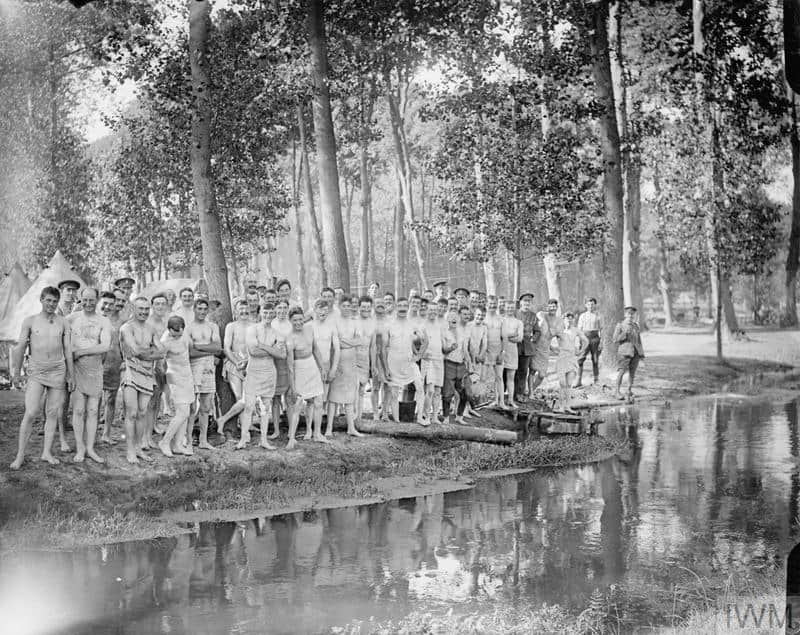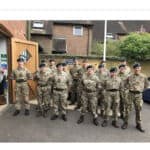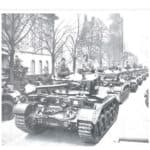Retreat from Mons
The Great Retreat, also known as the retreat from Mons, was the long withdrawal to the River Marne in August and September 1914 by the British Expeditionary Force and the French Fifth Army.
The Honour is borne on the Guidon of the 3rd Hussars.
Detail
Covered by its rear-guard of cavalry, the British Army continued its retirement. The 1st and 2nd Cavalry Brigades formed the rear-guard under General de Lisle, and the 3rd and 4th Cavalry Brigades acted as a left flank guard under General Allenby. A succession of positions was taken up and held without becoming seriously engaged.
Near Montrecourt in the early afternoon of the 25th, the 4th Cavalry Brigade came under shrapnel fire from the enveloping German cavalry on the left. The pursuit was now hotly pressed by German cavalry, large parties of whom were seen approaching Solesmes from the west, and Uhlan patrols were in the town.
The 3rd Hussars, with two troops as advanced guard, was ordered to push through Solesmes on to Viesly, and get into touch with the 4th Infantry Division. Several Uhlan patrols were encountered in the town by the advanced guard troops of ‘B’ Squadron, but all fled on being charged. One patrol swam the river in the face of fire from Uhlans at some thirty yards range; nobody was hit, and the Germans fled before the patrol had reached the bank. The remainder of the brigade followed the 3rd.
The Regiment was on the move again at 12.30 am on the 26th, coming to a halt at Inchy at 1.30 am only to carry on to Ligny at 4.30 am.
Meanwhile, the II Corps was digging in on the Le Cateau line, which from in front of Caudry on its left curved south-west to a mile and a half north-west of Ligny. The Germans were attacking the Le Cateau line, where General Smith-Dorrien had decided to stand and stem the German tide for a few hours.
The 4th Cavalry Brigade was on the left of the British line and watching that flank. The 3rd was ordered to the left of the British position and ‘A’ Squadron pushed forward to the cover of a bank close under the left of the infantry line, with the remainder of the Regiment in close support.
The Regiment was not called in until 8 pm and then ordered to Lempire, where the brigade was to billet.
The II Corps had been in a most precarious position at Le Cateau. Greatly outnumbered II Corps and the 4th Division, which had joined it, standing at bay to no less than four German corps, and two cavalry divisions.
“At length, it became apparent that, if complete annihilation was to be avoided, retirement must be attempted; and the order was given to commence it about 3.30 pm. The movement covered with the most devoted intrepidity and determination by the artillery, which had itself suffered heavily, and the fine work done by the cavalry in the further retreat from the position assisted materially in the final completion of this most difficult and dangerous operation” – Official Despatches
3.30 am of the 27th found a much diminished Regiment, short of rations, forage, and sleep assembled at the brigade rendezvous some mile and a half east of Lempire. The squadrons who had become detached during the night rejoined in the course of the day and reported that they had been commandeered by different generals who had used them on protective and other duties.
The brigade throughout the day covered the retirement of the 4th Division and gained touch with Sordet’s French Cavalry Corps, which marching around the British rear had taken post on the left. About noon the rear-guard became engaged with the enemy’s advanced troops and fell back to the northern edge of Lempire. The enemy developed a strong infantry attack, supported by guns at close range, and the brigade withdrew in the direction of Roisel.
At about 6 pm the brigade was ordered to move south to a billeting area which was repeatedly changed during the course of the march. Eventually, the column headed for Rouy, the Regiment’s ultimate billet, but with only a squadron of sadly tired men and horses and Headquarters reached about 1.30 in the morning and set down to what sleep they could in a field by the roadside.
At 5 am on the 28th the Regiment moved to a farm nearby, and parties were sent off reconnoitring for supplies. The missing squadrons shortly afterwards turned up, and the men were at last about to have a meal when the Regiment was ordered to turn out at once to take up a defensive position to the west and north, and hold the villages of Mesnil and Bethencourt, and to join up with the 5th Dragoon Guards at the latter place.
At about 11.45 am a strong force of French cavalry with guns passed through Mesnil moving north and presumably drove off the threatened attack. The 3rd remained in position until the rear-guard had all passed when at 12.30 the Regiment fell back to Nesle, where supplies were found dumped in the street by a Calvary. Nosebags and haversacks were filled, and going on to the place the Regiment halted and fed, after which a short ride brought us to our billets in Cressy.
The Regiment was now only about 350 strong. At 9.15 am, on the 29th, the ‘B’ echelon transport arrived. We had not seen it for a week From an early hour in the morning the Regiment remained in a state of constant readiness, horses saddled up, patrols out, etc. They had not the foggiest idea of any neighbouring troop.
At 12.30 pm the transport left for Roiglise, and at 1 o’clock the Regiment marched east to Ramecourt. Here ‘C’ Squadron was sent to the French, as a German force of all arms was reported at Eppeville marching south-west.
The 3rd remained at Ramecourt until 5 pm when the customary German aeroplane flew over and observed their position, but they left before the customary shells arrived. The billet at Roiglise was their next objective, but, on arriving there at 6.30 pm, it was discovered that it had been changed for Dives, and for Dives after watering and feeding they set forth.
The morning of the 30th came in with a thick fog. The Regiment was ordered to act as rear-guard to the brigade, and the Divisional Headquarters. The hour for starting was 6 am, but it was 8 o’clock before the 3rd began to retire. German cavalry was soon in touch with the rear parties, and Lieutenant Taylor’s troop was at one time separated from its line of retreat; but he cunningly worked round and rejoined; one of his scouts, surrounded by German cyclists, putting his horse into a gallop, escaped with a few grazes in the ribs, and a bullet-hole through his horse’s off-ear. It was a rear-guard fight through densely wooded and hilly country to Clairoix, which was reached about noon.
Here one squadron was left out in observation while the Regiment rode on to billet in Marigny just north of the River Oise at Compiegne. Luckily for them, six standing patrols which had been ordered out about eight miles in the direction we had come were, on the representations of the Colonel, cancelled.
At about 5 p.m. the 3rd was ordered out to reinforce the squadron which had been left out, for it was decided to retain a hold of the high ground on the right bank of the Oise. The line given to the Regiment was from Janville on the Oise on the right, westwards through Coudun to the crossroads by the railway a mile west of Giraumont on the left. The Carabiniers were to watch the Route d’Amiens southwest of this line with one troop.
The Regiment was in position by 7 pm, roads were barricaded and villages were held. The squadrons were deployed on a wide front, and communication was only possible along the actual front line. From about 4.30 am on the 31st the advanced posts were in touch with hostile patrols.
The 1st of September came in with a thick fog, and it was while marching to the brigade rendezvous at 6 am that the Brigadier-General commanding the artillery of the 4th Division ordered the 3rd to go to the assistance of the 1st Cavalry Brigade, which was being heavily attacked on bivouac at Nery.
The Regiment at once rode in that direction, and on arriving on the plateau above Nery ‘B’ Squadron was detached to the south-east of the village, while ‘A’ and ‘C’ moved to the high ground on its northern side. In the thick fog, it was difficult to discover what was going on.
The Nery combat ended, the Regiment, less ‘B’ Squadron, fell back to la Bossierre farm, where shrapnel began to burst about us. About 12.30 pm the Regiment was ordered by the General Commanding the 4th Division to cover the left flank during the retirement of his division from Verberie to Rary and Rully. At Rully we found the 4th Cavalry Brigade and ‘B’ Squadron.
The Regiment continued south at 7 o’clock, and the brigade eventually spent the night in Fontaine on the northern edge of the forest of Ermenonville, ‘A’ Squadron, which had covered the left of the 4th Division, arriving an hour a half later. Over the next couple of days, the Regiment made its way Lognes, where on the 3rd about 6 pm they bivouacked alongside Menier’s racing stables.



